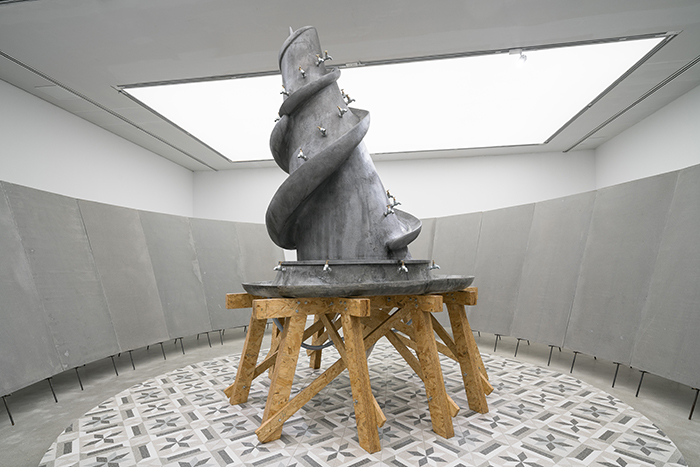Fi Churchman takes a wrong turn into absurdity
I’ve walked the wrong way through the installation. And by the wrong way, I mean off the designated path and into a sprawling mass of what looks like concrete-cast cannonballs and the broken pieces of some vast grey slab. The work, titled In the cold winter, the giants gather at the center of the square, playing marbles game with sand, according to the direction of the stars (all works 2019), is actually a clutter of planet-like spheres (148 of them), shooting meteors (complete with dust trails) and the broken bits of a constellation map, all moulded from greyish sand and resin. Some of the map’s pieces are embedded with planets, and we might imagine that ‘the giants’ have engaged in an overly enthusiastic marbles match, resulting in the destruction of the galaxy. Given that the sizes of the planet-marbles are somewhere between a big watermelon and a shotput, it’s as if the viewer is being situated as a cosmic-size giant (though not one who has played the game). I gingerly move out of the Milky Way.
Beijing artist Lu Lei’s Wander Giant is arranged across three rooms, each titled as a ‘Chapter’. I’ve just left ‘Chapter 1: Game of the Giants’, which also presents a series of artificially rusted aluminium-cast models of factories with improbably tall chimneys titled In the summer night, the giants use bat catchers to attract bats, and are positioned around the edges of the room. What are these factories? Are they where the bat catchers are made? What is a bat catcher, and why do the bats need catching?
In ‘Chapter 2: Reveries of the Giants’, more cast-aluminium sculptures: this time a pair of smooth grey busts, male and female, with giant glass lightbulbs for heads (W&H Were Hit by Lightning), which are however unlit; and two oversize cochleae, complete with semicircular canals and a trumpet-shaped outlet, each perched on a packing crate (Long Live the Roar!). The latter, instantly putting the viewer on a microlevel, incites a feeling of long absence evoked by the ash-grey ossified appearance of the sculptures, and by the strange irony in the disconnect between the disembodied ear-parts and the lightbulb heads gone kerflooey.
The last room (‘Chapter 3: The Giant Walking’) contains two concrete walls that curve either side of an aluminium Tatlin’s Tower-like water fountain. The Parentheses Corridor and Hand Washing Basins, rather than being an international powerhouse for the promotion of Communism, is a leaking minimonument set upon a low tiled platform. Thirty-two sets of plumbed-in taps circle their way up and around the tower, and dribble water down into the basin of the fountain. The dripping is the only sound that punctuates the room.
According to the exhibition information, Lu Lei takes the shapes of these sculptures from his childhood imagination. And it turns out the artist’s given the exhibition a different title in Chinese – Absurd Fiction. As someone wise once said, ‘Meanings is not important… I cannot be right all the time. Quite often I is left instead of right.’
Lu Lei, Wander Giant, Shanghart, Shanghai, 6 November – 15 March 2020
From the Spring 2020 issue of ArtReview Asia
